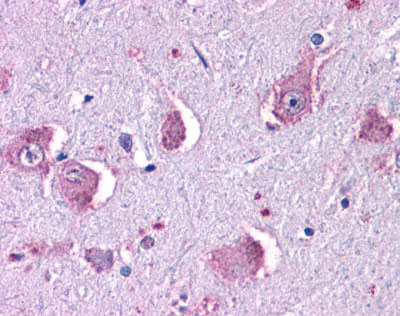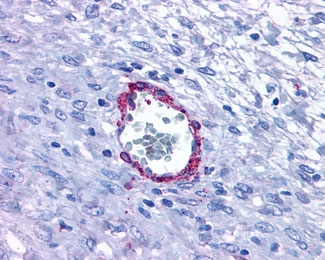HRH1 / Histamine H1 Receptor Antibody (Extracellular Domain)
Rabbit Polyclonal Antibody
- SPECIFICATION
- CITATIONS
- PROTOCOLS
- BACKGROUND

Application
| IHC-P |
|---|---|
| Primary Accession | P35367 |
| Reactivity | Human |
| Host | Rabbit |
| Clonality | Polyclonal |
| Calculated MW | 56kDa |
| Dilution | IHC-P (11 µg/ml) |
| Gene ID | 3269 |
|---|---|
| Other Names | Histamine H1 receptor, H1R, HH1R, HRH1 |
| Target/Specificity | Human HRH1 / Histamine H1 Receptor. BLAST analysis of the peptide immunogen showed no homology with other human proteins. |
| Reconstitution & Storage | Long term: -70°C; Short term: +4°C |
| Precautions | HRH1 / Histamine H1 Receptor Antibody (Extracellular Domain) is for research use only and not for use in diagnostic or therapeutic procedures. |
| Name | HRH1 (HGNC:5182) |
|---|---|
| Function | G-protein-coupled receptor for histamine, a biogenic amine that functions as an immune modulator and a neurotransmitter (PubMed:33828102, PubMed:8280179). Through the H1 receptor, histamine mediates the contraction of smooth muscles and increases capillary permeability due to contraction of terminal venules. Also mediates neurotransmission in the central nervous system and thereby regulates circadian rhythms, emotional and locomotor activities as well as cognitive functions (By similarity). |
| Cellular Location | Cell membrane; Multi-pass membrane protein |
| Volume | 50 µl |

Thousands of laboratories across the world have published research that depended on the performance of antibodies from Abcepta to advance their research. Check out links to articles that cite our products in major peer-reviewed journals, organized by research category.
info@abcepta.com, and receive a free "I Love Antibodies" mug.
Provided below are standard protocols that you may find useful for product applications.
Background
In peripheral tissues, the H1 subclass of histamine receptors mediates the contraction of smooth muscles, increase in capillary permeability due to contraction of terminal venules, and catecholamine release from adrenal medulla, as well as mediating neurotransmission in the central nervous system.
References
de Backer M.D.,et al.Biochem. Biophys. Res. Commun. 197:1601-1608(1993).
Fukui K.,et al.Biochem. Biophys. Res. Commun. 201:894-901(1994).
Moguilevsky N.,et al.Eur. J. Biochem. 224:489-495(1994).
Rae J.L.,et al.Submitted (SEP-1997) to the EMBL/GenBank/DDBJ databases.
Kitano T.,et al.Mol. Biol. Evol. 21:936-944(2004).
If you have used an Abcepta product and would like to share how it has performed, please click on the "Submit Review" button and provide the requested information. Our staff will examine and post your review and contact you if needed.
If you have any additional inquiries please email technical services at tech@abcepta.com.













 Foundational characteristics of cancer include proliferation, angiogenesis, migration, evasion of apoptosis, and cellular immortality. Find key markers for these cellular processes and antibodies to detect them.
Foundational characteristics of cancer include proliferation, angiogenesis, migration, evasion of apoptosis, and cellular immortality. Find key markers for these cellular processes and antibodies to detect them. The SUMOplot™ Analysis Program predicts and scores sumoylation sites in your protein. SUMOylation is a post-translational modification involved in various cellular processes, such as nuclear-cytosolic transport, transcriptional regulation, apoptosis, protein stability, response to stress, and progression through the cell cycle.
The SUMOplot™ Analysis Program predicts and scores sumoylation sites in your protein. SUMOylation is a post-translational modification involved in various cellular processes, such as nuclear-cytosolic transport, transcriptional regulation, apoptosis, protein stability, response to stress, and progression through the cell cycle. The Autophagy Receptor Motif Plotter predicts and scores autophagy receptor binding sites in your protein. Identifying proteins connected to this pathway is critical to understanding the role of autophagy in physiological as well as pathological processes such as development, differentiation, neurodegenerative diseases, stress, infection, and cancer.
The Autophagy Receptor Motif Plotter predicts and scores autophagy receptor binding sites in your protein. Identifying proteins connected to this pathway is critical to understanding the role of autophagy in physiological as well as pathological processes such as development, differentiation, neurodegenerative diseases, stress, infection, and cancer.



